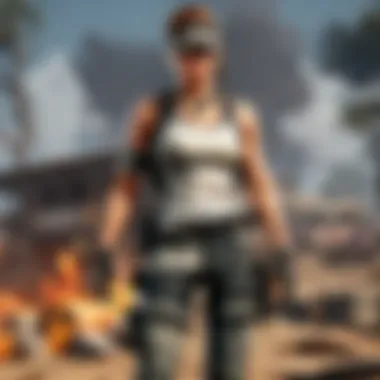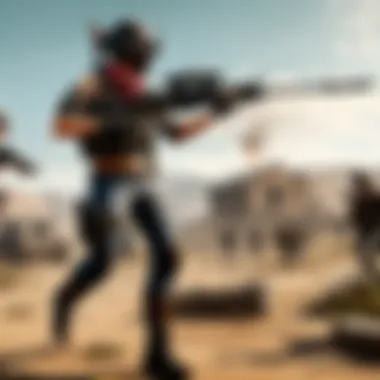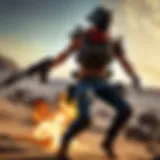Exploring PUBG: The Heart of Battleground Online Gaming


Intro
In the realm of online gaming, few titles have left an indelible mark quite like PlayerUnknown’s Battlegrounds, better known as PUBG. Released in 2017, this battle royale game took the gaming community by storm, inviting players into a vast and competitive world where strategy, skill, and a bit of luck are keys to survival. As the digital landscape continues to evolve, PUBG remains a critical player, adapting through updates and changes that keep the experience fresh and engaging.
The complexities of PUBG invite scrutiny, from its intricate mechanics to the vast community that thrives around it. Many players become captivated not only by the game’s gripping gameplay but also by the rich tapestry of experiences shared among its participants. Be it the thrill of outsmarting opponents or the camaraderie formed in squads, the game encompasses a myriad of human emotions paired with competitive spirit.
Whether you’re a seasoned veteran or a newcomer curious about the hype, this article endeavors to provide a thorough exploration of PUBG. Each segment will break down various elements—from game updates that influence player dynamics to strategic advice aimed at sharpening your gameplay. Additionally, we will touch on the vibrant esports scene that has sprung from this phenomenon, showcasing the game’s reach and its cultural relevance.
Through this narrative, we aim to furnish readers with a nuanced perspective on what makes PUBG a cornerstone of the online battleground genre. Prepare to dive deep into the expansive world of PUBG, illuminating the pathways that have shaped its journey and potential future.
Intro to Battleground Online Gaming
Battleground online gaming signifies a revolutionary shift in the gaming landscape, where players engage in virtual combat arenas with the objective of outlasting opponents in survival scenarios. This genre, particularly exemplified by games like PlayerUnknown's Battlegrounds (PUBG), transcends mere entertainment; it fosters a unique blend of strategy, camaraderie, and competition. The significance of understanding this genre lies in recognizing how it connects people from diverse backgrounds, uniting them in a shared quest for victory. Each match offers a fresh start, turning players into warriors who must adapt and strategize under pressure.
Historical Context of Online Gaming
Online gaming has come a long way since its inception. Originally, players interacted through text-based interfaces and rudimentary graphics. The mid-1990s ushered in the era of 3D graphics, which attracted larger audiences. However, it wasn’t until the advent of faster internet connections and the rise of multiplayer platforms that online gaming truly flourished. Games like "Counter-Strike" and "Quake" began to cultivate an atmosphere of digital competition, setting the stage for future emergent genres. By the early 2000s, MMOs (Massively Multiplayer Online games) introduced expansive worlds that captivated players, but their focus differed from the intense, player-versus-player dynamics that define battleground games today.
The Rise of Battleground Games
The battleground genre capitalizes on the adrenaline of spontaneity and survival. The concept gained traction in 2012, particularly with the introduction of mods like "DayZ," which inspired developers to explore this new gameplay style. PUBG, released in 2017, became a towering titan in this space.
In a typical battleground game, you parachute into a vast map, scramble for resources, and engage with foes until only one player or team remains. The combination of strategic planning and instinctive reaction evokes intense emotional responses. As players navigate through ever-shrinking safe zones and scramble to secure the most effective weapons, they develop a sense of urgency and competition that hooks them into repeated gameplay.
Battleground online gaming, with PlayerUnknown's Battlegrounds at its forefront, not only emphasizes individual skill but also highlights teamwork and communication. This unification of strategy and combat establishes a compelling and engaging context that continues to evolve. From its humble beginnings to its monumental influence today, the genre keeps players coming back, eager for more combat and camaraderie.
Overview of PlayerUnknown's Battlegrounds
The journey into the world of PlayerUnknown's Battlegrounds, commonly referred to as PUBG, is not merely about battling it out for survival. Rather, it unveils a blend of strategic gameplay complexities and community engagement that has reshaped the landscape of online gaming. PUBG stands as a pillar in the realm of battleground titles, illustrating how a game can achieve monumental success through innovation and player interaction.
Game Development and Release
As with many video games, the inception of PUBG is rooted in the vision of its creators. Originally launched in March 2017, the game was developed by PUBG Corporation, a subsidiary of Bluehole Studio. Brendan Greene, also known as PlayerUnknown, was the creative mind spearheading this project. He leveraged experiences from earlier mods, transforming ideas of unity, competition, and survival into a comprehensive digital experience. Upon release, PUBG quickly gained traction, thrilling players with its immersive mechanics.
The early access period helped to polish the game's elements based on player feedback, resulting in a meticulously crafted final product. The release on platforms like Steam served as a launchpad, contributing to its cult-like following and establishing PUBG as a frontrunner in the battle royale genre. Interestingly, developers continued to introduce various updates and expansions post-launch, ensuring that the community remained engaged and the gameplay fresh.
Mechanics of Gameplay
Gameplay in PUBG is both intense and rewarding, characterized by a few fundamental mechanics that set it apart from other titles. Initially, players are dropped from a plane onto a vast map, engaging in a fierce race to locate weapons, gear, and survival equipment. The battle royale format dictates that only one player or team can emerge on top, fostering a competitive spirit among participants.
- Map Dynamics: The various maps unfold unique environments—from barren landscapes to dense urban areas—each offering distinct strategies and survival tactics.
- Looting System: Players rummage through buildings and structures for weaponry and gear, making every encounter feel exhilarating and unpredictable.
- Safe Zones: The ever-shrinking play area forces players closer together, ramping up the tension and creating dynamic firefights as the match progresses.
Effective gameplay requires not just sharp shooting skills but an understanding of the mechanics at play. For instance, sound design plays a significant role; subtle audio cues can indicate enemy movements, making them precious for survival. Furthermore, players must assess the considerable variety of weapons and gear available, each with its unique impact on gameplay. The robustness of mechanics allowed PUBG to maintain a loyal player base, with many eager to continually refine their skills in an ever-changing battlefield.
As players adapt to strategies and mechanics within Hamburg’s chaotic streets or Erangel’s expansive fields, the real triumph lies not just in winning but mastering the myriad of techniques that shape each clash.
The success of PUBG is not simply built on game design; it thrives on the community it fosters. Collaboratively strategizing with friends or competing against rival clans serves to enhance the overall experience. This aspect keeps players returning, whether for casual play or serious competition. Through the examination of its development and gameplay mechanics, it becomes clear that PUBG transcends conventional online gaming, representing a vibrant ecosystem of player interactivity.
Core Mechanics and Features
Understanding the core mechanics and features of PUBG is essential for anyone looking to master the game. These elements not only define how the game is played but also shape the overall player experience. From environmental design to the customization of characters, each component plays a pivotal role in the battleground journey.
Map Design and Environments


The map design in PUBG is arguably one of the most important aspects of the game. It is not just a backdrop; it is a living, breathing element that influences everything from strategy to player interaction. The game features several vast maps, such as Erangel, Miramar, and the more recent addition, Vikendi. Each map has its own distinct environment, terrain, and weather patterns, requiring players to adapt their gameplay.
- Diverse Environments: The players encounter everything from urban landscapes to open deserts and snowy tundras. This variety ensures that no two matches are the same. For instance, Erangel offers lush forests and military bases, while Miramar challenges players with its arid conditions and rocky terrain.
- Dynamic Shrinking Zone: An infamous feature in PUBG is the blue zone. As time goes by, this area shrinks, forcing players into close quarters. Knowing the geography well can mean the difference between life and death as players compute where they need to move next. Players often share tips on forums such as Reddit to help one another learn the ins and outs of the various maps.
The intricacies of map design necessitate a mix of exploration and strategy, making it a cornerstone of PUBG’s appeal among its players.
Weapons and Equipment
No battleground experience is complete without a robust arsenal, and PUBG boasts a phenomenal variety of weapons and equipment. The availability of firearms, grenades, and tactical gear adds layers of strategy to the gameplay. Understanding how to effectively utilize these tools could very well be your lifeline.
- Guns Galore: From the trusty M416 to the heavy-hitting AWM, every weapon has its unique handling and performance characteristics. Players often experiment with different loadouts to find what suits their playstyle best.
- Equipment: Besides firearms, the game features a range of equipment like helmets, vests, and backpack types, which significantly affect survivability. For example, level 3 helmets can withstand more damage but are often harder to find.
- Consumables: Health kits, energy drinks, and boosting items allow players to heal and gain temporary advantages. Mastery of when and how to use these consumables can turn the tide in high-stakes scenarios.
Being proficient with the myriad weapons and understanding their strengths will drastically improve one’s chances of winning.
Character Customization
Character customization in PUBG is more than just cosmetic—it affects how players express themselves in the game. While the basics may be straightforward, the available options encourage creativity and personal branding in the highly competitive landscape of battleground gaming.
- Visual Styles: Players can choose skin options, outfits, and gear that reflect their uniqueness. While some prefer camouflaged gear for stealth, others opt for flashy outfits that stand out on the battlefield.
- Skill Representation: More experienced players often customize their characters in ways that represent their gaming prowess. It becomes a badge of honor, symbolizing not only ownership but also a mark of achievement within the community.
- In-Game Purchases and Unlockables: The introduction of events and skins encourages ongoing engagement. Players often participate in limited-time challenges to score rare outfits or accessories, further enriching their gaming experience.
In essence, while character customization may seem superficial at first glance, it provides a deeper sense of identity in this digital battleground.
"Customization leads to connection; players not only fight for survival but for their uniqueness in the world of PUBG."
Game Modes and Strategies
In the universe of PUBG, the mechanics of game modes and strategies are not mere details; they are the very lifeblood of each match. Understanding these aspects is paramount for players aiming to improve their competitive edge and enhance their overall gaming experience. Each mode offers unique challenges, fostering different styles of play that may emphasize either individual prowess or team dynamics. These modes can make or break a game's outcome, providing a canvas on which strategies are painted.
Solo vs. Squad Modes
At the heart of PUBG are the solo and squad modes. Playing solo is for those who prefer to go it alone, relying solely on their skills and instincts to survive. The thrill of facing off against an entire lobby without the safety net of teammates can be both exhilarating and nerve-wracking. In solo mode, players need to remain agile, consistently scouting for supplies while watching their backs. Positioning becomes critical, as any misstep can lead to a sudden end.
Squad mode, on the other hand, brings camaraderie into the mix. Teams of four players can coordinate their efforts, combining their strengths and mitigating weaknesses. Strong communication is essential; providing callouts, strategizing land drops, and sharing loot can significantly impact the success of the squad. Working together to outmaneuver opponents often outweighs individual skill, turning the tide of battle in their favor. This environment promotes not just individual improvement, but also a profound appreciation for teamwork.
Effective Team Strategies
Elevating gameplay in squad modes relies heavily on effective strategies. While every team may develop its own flair, some core principles hold true across the board.
- Communication is key. Establishing a system of callouts, whether it’s marking locations on the map or shouting out enemy positions, fosters better coordination.
- Landing Zones need to be pre-determined. Choosing the right drop location can set the tone for the rest of the game, allowing the squad to gather crucial resources without too much early interference.
- Role Distribution often proves beneficial. Designating roles, such as sniper, medic, and scout, helps to cover various aspects of gameplay, ensuring balanced skill application throughout the match.
- Map Awareness plays a critical role as well. Maintaining awareness of the shrinking zone while considering the strategies of other squads can provide valuable insights and opportunities for ambush or escape.
"In PUBG, the art of war is not about strength, but about wits. Tactical thinking often trumps mere firepower."
Survival Techniques
Surviving in the battleground often comes down to adopting smart survival techniques. Regardless of the mode played, the goal is to be the last one standing.
- Utilizing Terrain is crucial. Knowing when to take cover behind rocks or trees gives players a tactical advantage over their foes. Terrain can also dictate movement; staying in brush conceals visibility, allowing for stealthy maneuvers.
- Inventory Management cannot be overlooked. Holding onto vital items like health kits while also ensuring adequate ammo and grenades requires a keen understanding of the essential survival goods.
- Situational Awareness is your best friend. Being aware of sound cues—like gunfire in the distance or the sound of footsteps—can help players to make split-second decisions that often can be the difference between life and death.
- Adapting Strategies is also necessary. The dynamic nature of matches means that what works today might not work tomorrow. Flexibility in tactics will ensure that a player remains adaptable to the chaos.
In summary, mastering the array of game modes and strategies in PUBG enhances not only individual skills but also adds layers of enjoyment to the experience. Understanding when to play solo or a squad, implementing effective teamwork strategies, and employing survival techniques can all culminate in a more refined and successful gaming venture.
Community and Cultural Impact
Battleground online games, particularly PUBG, have changed the landscape of gaming significantly. The cultural impact of PUBG is immense, extending beyond just gameplay into social interactions, community building, and even trends that affect global culture.
The PUBG Fandom


The fandom surrounding PUBG represents a diverse group of players—a microcosm of the gaming community itself. These fans often engage in discussions on forums such as Reddit or join social media groups on platforms like Facebook. They create and share content ranging from gameplay highlights to fan art. This kind of engagement fosters a sense of belonging, turning casual players into dedicated fans who support each other and exchange strategies.
Players can often be spotted decked out in PUBG merchandise or showcasing their in-game stats on streaming platforms where they share their gameplay live.
"In the world of gaming, standing together is half the battle. The other half? Knowing who has your back in a firefight."
One notable aspect of the PUBG fandom is the way players express their dearly-held beliefs and values in their gaming communities. The fandom does not merely celebrate wins and achievements but also welcomes discussions about ethics, competition, and fairness in gaming.
Esports and Tournaments
PUBG has carved a niche in the esports realm, with tournaments drawing significant attention globally. Competitions like the PUBG Global Invitational attract fans and players alike, highlighting the game's competitive nature. These events showcase elite players demonstrating head-spinning tactics and seamless teamwork, turning onlookers into avid supporters.
The structure of these tournaments aids in creating a competitive yet respectful environment. Players participate not just for the thrill but also for substantial prizes and recognition. Seeing different nationalities compete contributes to a unique cultural exchange, with fans gaining insights into different play styles and strategies.
These events foster not just competition, but community. Fans often create watch parties, turning their homes into arenas where they cheer for their favorite teams. This communal experience solidifies the game's place in modern esports.
Social Media Influence
The ripple effect of PUBG’s community can be seen vividly on social media. Platforms like Twitch and YouTube serve as the primary canvas for players to showcase their skills, attracting millions of viewers. Streamers often participate directly with their audience, creating a two-way communication channel that enhances the gaming experience.
Moreover, trends sometimes originate from social media, such as memes or challenges that circulate among players, adding layers of fun and camaraderie. Hashtags and viral videos can spark new strategies, engaging players far beyond their immediate gaming environment.
One must acknowledge, however, that social media can have its downsides. Toxic behavior sometimes permeates discussions, but many community leaders take proactive steps to address it, promoting a more inclusive atmosphere.
Trends and Future Directions
The landscape of online gaming is ever-changing, influenced by a slew of factors from technological advancements to shifts in player behavior. Specifically for PUBG, these trends offer a glimpse into how the game may evolve while staying relevant and engaging in a hectic gaming ecosystem. Understanding these trends not only amplifies a player's experience but also allows fans and developers to appreciate the intricate web of choices affecting gameplay.
Technology Advancements in Gameplay
Innovations in technology are at the heart of enhancing the gaming experience. With every passing year, we see leaps made in both hardware and software that push the boundaries of what’s possible. Mobile devices have become a formidable platform for gaming, including PUBG, which has released a mobile version captivating millions.
High-definition graphics, real-time ray tracing, and advanced AI are shaping how players interact with the environment. For instance, new hardware like the PlayStation 5 and Xbox Series X allows for smoother frame rates and heightened realism in graphics.
Benefits of these advancements include:
- Improved Accessibility: Players can engage with full features now on a variety of devices.
- Enhanced Realism: The gameplay interactivity reaches new heights when graphics and physics work in tandum, making the battlefield feel alive.
- Increased Engagement: Spectators can now enjoy matches with astonishing clarity, fueling the esports scene.
Potential Updates and Expansions
Looking ahead, updates and expansions remain crucial for sustaining interest in PUBG. Developers constantly seek ways to extend gameplay longevity, introducing new maps, modes, and features that keep the community buzzing. The recent addition of the "Erangel 2.0" map showcased a significant overhaul, featuring updated visuals and new gameplay mechanics.
Future updates might delve deeper into:
- Player Customization: More visual personalization options signify a focus on individuality within the game. Players love sporting unique looks that showcase their in-game achievements.
- New Game Modes: Expanding options could bring in gameplay styles that cater to niche audiences, such as PvE experiences or cooperative survival modes against AI enemies.
- Seasonal Events: Timed events often breathe new life into the game, encouraging players to return for limited-time rewards.
Changing Player Dynamics
The gaming community surrounding PUBG is as varied as they come. Casual players, hardcore gamers, and esports pros all have their unique expectations and behaviors. As gaming evolves, player dynamics shift correspondingly. Casual players usually seek entertainment and social interactions, while competitive players chase victory and rankings.
This transformation leads to key observations:
- Community Engagement: As players increasingly turn to online platforms like Reddit and Discord to connect, the sense of community strengthens. Engaging retrospectives and discussions elevate gameplay understanding.
- Skill Development: Over time, players improve through practice but also through the exchange of strategies, tips, and tricks. Learning from experienced players often helps ease newcomers into the competitive environment.
- Influence of Streamers: High-profile streamers and content creators influence gameplay trends, and watching someone play can create intriguing shifts in how strategies and tactics evolve.


"The future of gaming isn't just in what you play, but how you connect and share your journey with others."
In sum, these trends enrich the PUBG experience and keep the game alive. By embracing technology, introducing engaging updates, and understanding shifting player dynamics, PUBG stands poised for a promising future, continuously capturing the hearts and minds of gamers worldwide.
Player Perspectives and Experiences
In the ever-expanding universe of PUBG, the experiences of players serve not only as personal narratives, but also as vital threads that weave the fabric of the game's community. Understanding how various players perceive their engagements offers rich insights into the game's mechanics, culture, and evolution. Player perspectives highlight how diverse experiences can impact skill development, social interaction, and emotional investment. Beyond statistics and gameplay strategies, incorporating these players' viewpoints enhances appreciation of the intricate dynamics of PUBG's ecosystem.
Interviews with Top Players
Hearing directly from top-tier players sheds light on the level of commitment and tactical acumen needed to rise through the ranks in PUBG. These individuals often dedicate countless hours to perfecting their strategies, analyzing gameplay, and mastering maps. Interviewing them can reveal not just their gameplay mechanics but also the psychological aspects of competition that fuel their drive to succeed.
For instance, players like Shroud or Ninja illustrate how adaptability is crucial in different game scenarios. Their experiences emphasize the significance of constant learning and innovation in overcoming formidable foes. Through candid conversations, fans witness the mentality that goes into professional gaming.
"Each match is a new lesson; if you stop learning, you might as well stop playing." — A renowned pro player shares this thought, encapsulating the essence of growth in PUBG.
Additionally, interviews can shed light on the evolving nature of professional gaming. Players often discuss their thoughts on trends, viewer interactions, and the transformation of gameplay due to the pressures from fans and competition.
Casual vs. Competitive Play
The divide between casual gamers and serious competitors in PUBG is pronounced. Both groups relish different aspects of the game, yet they often intersect in vibrant ways. Casual players usually engage for sheer enjoyment and exploration of the expansive maps without the pressures tied to ranking systems.
- Casual play focuses on getting familiar with game mechanics, enjoying the scenery, and experimenting with weapons without the fear of consequences.
- Players tend to form bonds in casual settings, leading to fun-filled moments and shared laughter, which ultimately fortify the game’s community.
In contrast, competitive players fixate on strategies, teamwork, and improving their skills. Every movement is calculated, and mistakes can be costly. Their dedication often leads them to analyze each match stringently, searching for weaknesses to exploit in subsequent encounters.
Some key differences include:
- Mindset: Casual players adopt a more relaxed approach, while competitive gamers are driven by results.
- Playtime: Casual players dip in and out as time permits; however, dedicated players often schedule rigorous training sessions.
- Communication: Team strategies in competitive settings demand effective communication, whereas casual players thrive on improvisation and camaraderie.
As both communities coexist, there is potential for cross-pollination. Casual gamers may find inspiration in competitive techniques, while competitive players might relish moments of levity that casual play offers. This fascinating blend ultimately enriches PUBG, making the experiences of both groups invaluable in maintaining the game's vibrant ecosystem.
For further exploration of player dynamics in PUBG, consider visiting PUBG's official website.
To dive deeper into community discussions, check out forums on Reddit where various play styles are dissected and shared!
Whether you find yourself drawn to the thrill of competition or the joy of casual play, recognizing and valuing each player's perspective can only enhance our understanding of this remarkable game.
Epilogue and Reflection
In examining the expansive realm of battleground online gaming through the lens of PUBG, we find a richly layered tapestry that speaks volumes about its impact on both players and the gaming community at large. This final section navigates the significance of the observations we've made throughout the article, bringing to light essential considerations and insights that resonate with players and esports aficionados alike.
The importance of this conclusion lies in consolidating the extensive exploration of PUBG's mechanics, community dynamics, and cultural repercussions. An appreciation for these elements not only enhances our comprehension but also positions players to engage with the game on a deeper level. Without a doubt, understanding player strategies, core gameplay elements, and the community fabric reaffirms PUBG's stature in the gaming realm.
Summary of Key Insights
- Evolution of Gameplay: PUBG revolutionized online gaming with its battle royale format, uniting players in competitive gameplay that emphasizes strategy and adaptability.
- Community Engagement: The game's strong community presence fosters connections among players, fueling discussions, collaborations, and often, lifelong friendships. The multiplayer experience is enriched by these interactions.
- Cultural Impact: From inspired memes to esports tournaments, PUBG has transcended its gaming roots, influencing broader cultural trends and conversations around digital interaction.
- Strategic Depth: The multitude of strategies employed by players, ranging from solo tactics to team dynamics, demonstrates the game’s complexity and the mental acuity required to succeed.
In sum, the collective insights not only showcase the mechanics and features that make PUBG engaging but also highlight players' indispensable role in shaping its ongoing narrative.
The Legacy of PUBG in Gaming
PUBG's legacy is woven into the fabric of online gaming history. When launched, it was groundbreaking, carving out a niche that inspired a plethora of similar games, thereby challenging the status quo of multiplayer experiences.
With its realistic graphics, immersive environments, and dynamic gameplay, it paved the way for other titles to explore the battle royale genre. Unlike its contemporaries, PUBG honors a blend of tactics and visceral realism that resonates with many players aiming for a more authentic experience.
"PUBG is more than a game; it’s a digital landscape where friendships grow, competition thrives, and thousands of players brave the odds together."
The game's cultural footprint extends well beyond the screen. With leagues, tournaments, and an ever-growing player base, it underscores the rise of esports, where players can achieve fame and recognition. This phenomenon has transformed gaming from a solitary activity into a vibrant community engagement arena.
Furthermore, the influence of PUBG on game development practices cannot be overstated. Its success has encouraged developers to rely heavily on community feedback, emphasizing user experience that’s both responsive and engaging. The structure created by PUBG has become foundational for future online games, encouraging innovations that hinge on player interaction and satisfaction.



